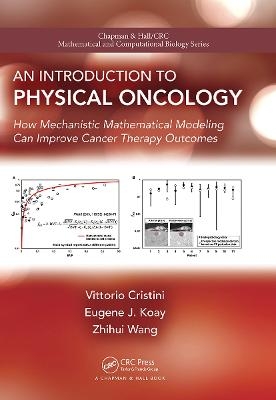
An Introduction to Physical Oncology
How Mechanistic Mathematical Modeling Can Improve Cancer Therapy Outcomes
Seiten
2021
Chapman & Hall/CRC (Verlag)
978-1-032-24279-8 (ISBN)
Chapman & Hall/CRC (Verlag)
978-1-032-24279-8 (ISBN)
This book introduces the emerging field of physical oncology, and includes recent breakthroughs in how novel mathematical models of physical transport processes incorporate patient tissue and imaging data routinely produced in the clinic to predict the efficacy of many cancer treatment approaches, including chemotherapy and radiation therapy.
Physical oncology has the potential to revolutionize cancer research and treatment. The fundamental rationale behind this approach is that physical processes, such as transport mechanisms for drug molecules within tissue and forces exchanged by cancer cells with tissue, may play an equally important role as biological processes in influencing progression and treatment outcome.
This book introduces the emerging field of physical oncology to a general audience, with a focus on recent breakthroughs that help in the design and discovery of more effective cancer treatments. It describes how novel mathematical models of physical transport processes incorporate patient tissue and imaging data routinely produced in the clinic to predict the efficacy of many cancer treatment approaches, including chemotherapy and radiation therapy. By helping to identify which therapies would be most beneficial for an individual patient, and quantifying their effects prior to actual implementation in the clinic, physical oncology allows doctors to design treatment regimens customized to each patient’s clinical needs, significantly altering the current clinical approach to cancer treatment and improving the outcomes for patients.
Physical oncology has the potential to revolutionize cancer research and treatment. The fundamental rationale behind this approach is that physical processes, such as transport mechanisms for drug molecules within tissue and forces exchanged by cancer cells with tissue, may play an equally important role as biological processes in influencing progression and treatment outcome.
This book introduces the emerging field of physical oncology to a general audience, with a focus on recent breakthroughs that help in the design and discovery of more effective cancer treatments. It describes how novel mathematical models of physical transport processes incorporate patient tissue and imaging data routinely produced in the clinic to predict the efficacy of many cancer treatment approaches, including chemotherapy and radiation therapy. By helping to identify which therapies would be most beneficial for an individual patient, and quantifying their effects prior to actual implementation in the clinic, physical oncology allows doctors to design treatment regimens customized to each patient’s clinical needs, significantly altering the current clinical approach to cancer treatment and improving the outcomes for patients.
Vittorio Cristini, The University of Texas Health Science Center at Houston, USA. Eugene Koay, MD Anderson Cancer Center, USA. Zhihui Wang, The University of Texas Health Science Center at Houston, USA.
What Should Be Modeled in Cancer: Milestones for Physical Models. Developing More Successful Cancer Treatments with Physical Oncology. Mathematical Pathology. Mathematical Modeling of Drug Response. Prediction of Chemotherapy Outcome in Patients. Clinical Management of Pancreatic Cancer. Application of Cancer Physics in the Clinic. Tumor Morphological Behavior and Treatment Outcome. Mechanistic Model of Tumor Response to Immunotherapy. Perspectives on Physical Oncology and Future Directions
| Erscheinungsdatum | 14.12.2021 |
|---|---|
| Reihe/Serie | Chapman & Hall/CRC Mathematical Biology Series |
| Zusatzinfo | 66 Illustrations, black and white |
| Sprache | englisch |
| Maße | 178 x 254 mm |
| Gewicht | 376 g |
| Themenwelt | Mathematik / Informatik ► Mathematik ► Angewandte Mathematik |
| Medizin / Pharmazie ► Physiotherapie / Ergotherapie ► Orthopädie | |
| Medizin / Pharmazie ► Studium ► 1. Studienabschnitt (Vorklinik) | |
| Naturwissenschaften ► Biologie | |
| Naturwissenschaften ► Physik / Astronomie | |
| Technik ► Medizintechnik | |
| Technik ► Umwelttechnik / Biotechnologie | |
| ISBN-10 | 1-032-24279-5 / 1032242795 |
| ISBN-13 | 978-1-032-24279-8 / 9781032242798 |
| Zustand | Neuware |
| Informationen gemäß Produktsicherheitsverordnung (GPSR) | |
| Haben Sie eine Frage zum Produkt? |
Mehr entdecken
aus dem Bereich
aus dem Bereich
Buch | Softcover (2024)
Springer Vieweg (Verlag)
CHF 53,15
Buch | Softcover (2024)
Springer Vieweg (Verlag)
CHF 62,95


